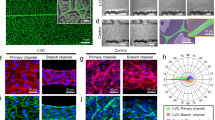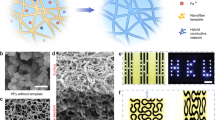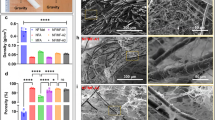Abstract
Tissue-engineered grafts may be useful in myocardial repair; however, previous scaffolds have been structurally incompatible with recapitulating cardiac anisotropy. Here, we use microfabrication techniques to create an accordion-like honeycomb microstructure in poly(glycerol sebacate), which yields porous, elastomeric three-dimensional (3D) scaffolds with controllable stiffness and anisotropy. Accordion-like honeycomb scaffolds with cultured neonatal rat heart cells demonstrated utility through: (1) closely matched mechanical properties compared to native adult rat right ventricular myocardium, with stiffnesses controlled by polymer curing time; (2) heart cell contractility inducible by electric field stimulation with directionally dependent electrical excitation thresholds (p<0.05); and (3) greater heart cell alignment (p<0.0001) than isotropic control scaffolds. Prototype bilaminar scaffolds with 3D interconnected pore networks yielded electrically excitable grafts with multi-layered neonatal rat heart cells. Accordion-like honeycombs can thus overcome principal structural–mechanical limitations of previous scaffolds, promoting the formation of grafts with aligned heart cells and mechanical properties more closely resembling native myocardium.
This is a preview of subscription content, access via your institution
Access options
Subscribe to this journal
Receive 12 print issues and online access
$259.00 per year
only $21.58 per issue
Buy this article
- Purchase on Springer Link
- Instant access to full article PDF
Prices may be subject to local taxes which are calculated during checkout





Similar content being viewed by others
References
Macchiarelli, G. et al. A micro-anatomical model of the distribution of myocardial endomysial collagen. Histol. Histopathol. 17, 699–706 (2002).
Hanley, P. J., Young, A. A., LeGrice, I. J., Edgar, S. G. & Loiselle, D. S. Three dimensional configuration of perimysial collagen fibres in rat cardiac muscle at resting and extended sarcomere lengths. J. Physiol. 517, 831–837 (1999).
Holmes, J. W., Borg, T. K. & Covell, J. W. Structure and mechanics of healing myocardial infarcts. Annu. Rev. Biomed. Eng. 7, 223–253 (2005).
Costa, K. D., Lee, E. J. & Holmes, J. W. Creating alignment and anisotropy in engineered heart tissue: Role of boundary conditions in a model three-dimensional culture system. Tissue Eng. 9, 567–577 (2003).
Akhyari, P. et al. Mechanical stretch regimen enhances the formation of bioengineered autologous cardiac muscle grafts. Circulation 106, I137–I142 (2002).
Fink, C. et al. Chronic stretch of engineered heart tissue induces hypertrophy and functional improvement. FASEB J. 14, 669–679 (2000).
Radisic, M. et al. Functional assembly of engineered myocardium by electrical stimulation of cardiac myocytes cultured on scaffolds. Proc. Natl Acad. Sci. USA 101, 18129–18134 (2004).
Bursac, N. et al. Cardiac muscle tissue engineering: Toward an in vitro model for electrophysiological studies. Am. J. Physiol. Heart Circ. Physiol. 277, H433–444 (1999).
Papadaki, M. et al. Tissue engineering of functional cardiac muscle: Molecular, structural, and electrophysiological studies. Am. J. Physiol. Heart Circ Physiol. 280, H168–H178 (2001).
Yeo, Y. et al. Photocrosslinkable hydrogel for myocyte cell culture and injection. J. Biomed. Mater. Res. B 81, 312–322 (2007).
Zimmermann, W. H. et al. Engineered heart tissue grafts improve systolic and diastolic function in infarcted rat hearts. Nature Med. 12, 452–458 (2006).
Feng, Z., Matsumoto, T. & Nakamura, T. Measurements of the mechanical properties of contracted collagen gels populated with rat fibroblasts or cardiomyocytes. J. Artif Organs 6, 192–196 (2003).
Ott, H. C. et al. Perfusion-decellularized matrix: Using nature’s platform to engineer a bioartificial heart. Nature Med. 14, 213–221 (2008).
Wang, Y., Ameer, G. A., Sheppard, B. J. & Langer, R. A tough biodegradable elastomer. Nature Biotechnol. 20, 602–606 (2002).
Wang, Y., Kim, Y. M. & Langer, R. In vivo degradation characteristics of poly(glycerol sebacate). J. Biomed. Mater. Res. A 66, 192–197 (2003).
Bettinger, C. J., Orrick, B., Misra, A., Langer, R. & Borenstein, J. T. Microfabrication of poly (glycerol-sebacate) for contact guidance applications. Biomaterials 27, 2558–2565 (2006).
Bettinger, C. J. et al. Three-dimensional microfluidic tissue-engineering scaffolds using a flexible biodegradable polymer. Adv. Mater. 18, 165 (2006).
Radisic, M. et al. Oxygen gradients correlate with cell density and cell viability in engineered cardiac tissue. Biotechnol. Bioeng. 93, 332–343 (2006).
Chuong, C. J., Sacks, M. S., Templeton, G., Schwiep, F. & Johnson, R. L. Jr. Regional deformation and contractile function in canine right ventricular free wall. Am. J. Physiol. 260, H1224–H1235 (1991).
Rappaport, D., Adam, D., Lysyansky, P. & Riesner, S. Assessment of myocardial regional strain and strain rate by tissue tracking in B-mode echocardiograms. Ultrasound Med. Biol. 32, 1181–1192 (2006).
Sacks, M. S. & Chuong, C. J. Biaxial mechanical properties of passive right ventricular free wall myocardium. J. Biomech. Eng. 115, 202–205 (1993).
Kocica, M. J. et al. The helical ventricular myocardial band: Global, three-dimensional, functional architecture of the ventricular myocardium. Eur. J. Cardiothorac. Surg. 29, S21–S40 (2006).
Streeter, D. D. Jr, Spotnitz, H. M., Patel, D. P., Ross, J. Jr & Sonnenblick, E. H. Fiber orientation in the canine left ventricle during diastole and systole. Circ. Res. 24, 339–347 (1969).
Bautista-Hernandez, V. et al. Coarctectomy reduces neoaortic arch obstruction in hypoplastic left heart syndrome. J. Thorac. Cardiovasc. Surg. 133, 1540–1546 (2007).
Reinhartz, O. et al. Homograft valved right ventricle to pulmonary artery conduit as a modification of the Norwood procedure. Circulation 114, I594–I599 (2006).
Kinch, J. W. & Ryan, T. J. Right ventricular infarction. N. Engl. J. Med. 330, 1211–1217 (1994).
Gumina, R. J., Murphy, J. G., Rihal, C. S., Lennon, R. J. & Wright, R. S. Long-term survival after right ventricular infarction. Am. J. Cardiol. 98, 1571–1573 (2006).
Gao, J., Crapo, P. M. & Wang, Y. Macroporous elastomeric scaffolds with extensive micropores for soft tissue engineering. Tissue Eng. 12, 917–925 (2006).
Chen, Q. Z. et al. Characterisation of a soft elastomer poly(glycerol sebacate) designed to match the mechanical properties of myocardial tissue. Biomaterials 29, 47–57 (2008).
Radisic, M. et al. Pre-treatment of synthetic elastomeric scaffolds by cardiac fibroblasts improves engineered heart tissue. J. Biomed. Mater. Res. A 86, 713–724 (2008).
Radisic, M. et al. Biomimetic approach to cardiac tissue engineering: Oxygen carriers and channeled scaffolds. Tissue Eng. 12, 2077–2091 (2006).
Crapo, P. M., Gao, J & Wang, Y. Seamless tubular poly(glycerol sebacate) scaffolds: High-yield fabrication and potential applications. J. Biomed. Mater. Res. A 86, 354–363 (2008).
Boublik, J. et al. Mechanical properties and remodeling of hybrid cardiac constructs made from heart cells, fibrin, and biodegradable, elastomeric knitted fabric. Tissue Eng. 11, 1122–1132 (2005).
Cheng, M., Park, H., Engelmayr, G. C., Moretti, M. & Freed, L. E. Effects of regulatory factors on engineered cardiac tissue in vitro. Tissue Eng. 13, 2709–2719 (2007).
Cheng, M., Moretti, M., Engelmayr, G. C. Jr & Freed, L. E. Insulin-like growth factor-I and perfusion enhance the formation of tissue engineered cardiac grafts. Tissue Eng. 10.1089/ten.tea.2008.0077 (in the press; PMID: 18759675).
Bardou, A. L. et al. Directional variability of stimulation threshold measurements in isolated guinea pig cardiomyocytes: Relationship with orthogonal sequential defibrillating pulses. Pacing Clin. Electrophysiol. 13, 1590–1595 (1990).
Ranjan, R. & Thakor, N. V. Electrical stimulation of cardiac myocytes. Ann. Biomed. Eng. 23, 812–821 (1995).
Bursac, N. et al. Cultivation in rotating bioreactors promotes maintenance of cardiac myocyte electrophysiology and molecular properties. Tissue Eng. 9, 1243–1253 (2003).
Engelmayr, G. C. Jr, Papworth, G. D., Watkins, S. C., Mayer, J. E. Jr & Sacks, M. S. Guidance of engineered tissue collagen orientation by large-scale scaffold microstructures. J. Biomech. 39, 1819–1831 (2006).
Nichol, J. W., Engelmayr, G. C. Jr, Cheng, M. & Freed, L. E. Co-culture induces alignment in engineered cardiac constructs via MMP-2 expression. Biochem. Biophys. Res. Commun. 373, 360–365 (2008).
Sacks, M. S., Smith, D. B. & Hiester, E. D. A small angle light scattering device for planar connective tissue microstructural analysis. Ann. Biomed. Eng. 25, 678–689 (1997).
Shimizu, T. et al. Polysurgery of cell sheet grafts overcomes diffusion limits to produce thick, vascularized myocardial tissues. FASEB J. 20, 708–710 (2006).
Borenstein, J. T. et al. Microfabrication of three-dimensional engineered scaffolds. Tissue Eng. 13, 1837–1844 (2007).
Camelliti, P., Gallagher, J. O., Kohl, P. & McCulloch, A. D. Micropatterned cell cultures on elastic membranes as an in vitro model of myocardium. Nature Protocols 1, 1379–1391 (2006).
Feinberg, A. W. et al. Muscular thin films for building actuators and powering devices. Science 317, 1366–1370 (2007).
Radisic, M. et al. Medium perfusion enables engineering of compact and contractile cardiac tissue. Am. J. Physiol. Heart Circ. Physiol. 286, H507–H516 (2004).
Dvir, T., Benishti, N., Shachar, M. & Cohen, S. A novel perfusion bioreactor providing a homogenous milieu for tissue regeneration. Tissue Eng. 12, 2843–2852 (2006).
Dvir, T., Levy, O., Shachar, M., Granot, Y. & Cohen, S. Activation of the ERK1/2 cascade via pulsatile interstitial fluid flow promotes cardiac tissue assembly. Tissue Eng. 13, 2185–2193 (2007).
Dahotre, N. B. & Harimkar, S. P. Laser Fabrication and Machining of Materials (Springer Science Business Media, 2008).
Neeley, W. L. et al. A microfabricated scaffold for retinal progenitor cell grafting. Biomaterials 29, 418–426 (2008).
Ng, C. P., Hinz, B. & Swartz, M. A. Interstitial fluid flow induces myofibroblast differentiation and collagen alignment in vitro. J. Cell. Sci. 118, 4731–4739 (2005).
Ayres, C. E. et al. Measuring fiber alignment in electrospun scaffolds: A user’s guide to the 2D fast Fourier transform approach. J. Biomater. Sci. Polym. Ed. 19, 603–621 (2008).
Sander, E. A. & Barocas, V. H. Comparison of 2D fiber network orientation measurement methods. J. Biomed. Mater. Res. A (2008).
Acknowledgements
Financial support for this work was provided by NIH NRSA fellowship 1 F32 HL084968-01 (to G.C.E.), a Charles Stark Draper fellowship (to C.J.B.), NASA Grant NNJ04HC72G (to L.E.F.) and NIH Grant DE013023 (to R.L.). We are indebted to Y. Wang and M. Radisic for advice on porogen-leached PGS scaffolds, S.N. Bhatia, D. Albright and D. Ward for advice on PGS membrane microfabrication, N. Watson and E. Batchelder for help with confocal and electron microscopy and S. Kangiser for help with manuscript preparation.
Author information
Authors and Affiliations
Corresponding author
Supplementary information
Supplementary Information
Supplementary Information (PDF 1366 kb)
Supplementary Information
Supplementary Movie (AVI 8579 kb)
Rights and permissions
About this article
Cite this article
Engelmayr, G., Cheng, M., Bettinger, C. et al. Accordion-like honeycombs for tissue engineering of cardiac anisotropy. Nature Mater 7, 1003–1010 (2008). https://doi.org/10.1038/nmat2316
Received:
Accepted:
Published:
Issue Date:
DOI: https://doi.org/10.1038/nmat2316
This article is cited by
-
The role of three-dimensional scaffolds based on polyglycerol sebacate/ polycaprolactone/ gelatin in the presence of Nanohydroxyapatite in promoting chondrogenic differentiation of human adipose-derived mesenchymal stem cells
Biological Procedures Online (2023)
-
Leaf-venation-directed cellular alignment for macroscale cardiac constructs with tissue-like functionalities
Nature Communications (2023)
-
Engineering micro/nano-fibrous scaffolds with silver coating for tailored wound repair applications
Journal of Nanoparticle Research (2023)
-
Bioinspired elastomer composites with programmed mechanical and electrical anisotropies
Nature Communications (2022)
-
Microengineered platforms for characterizing the contractile function of in vitro cardiac models
Microsystems & Nanoengineering (2022)



